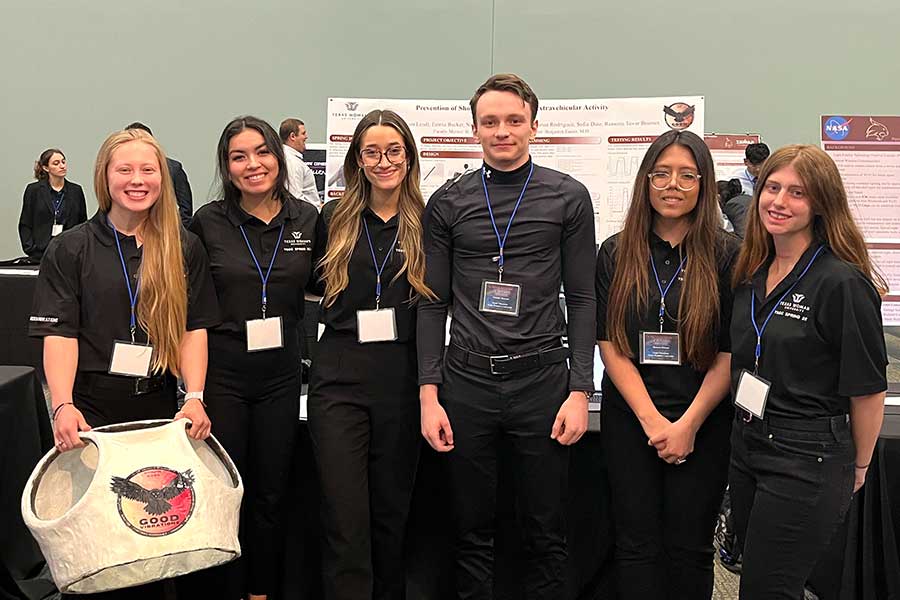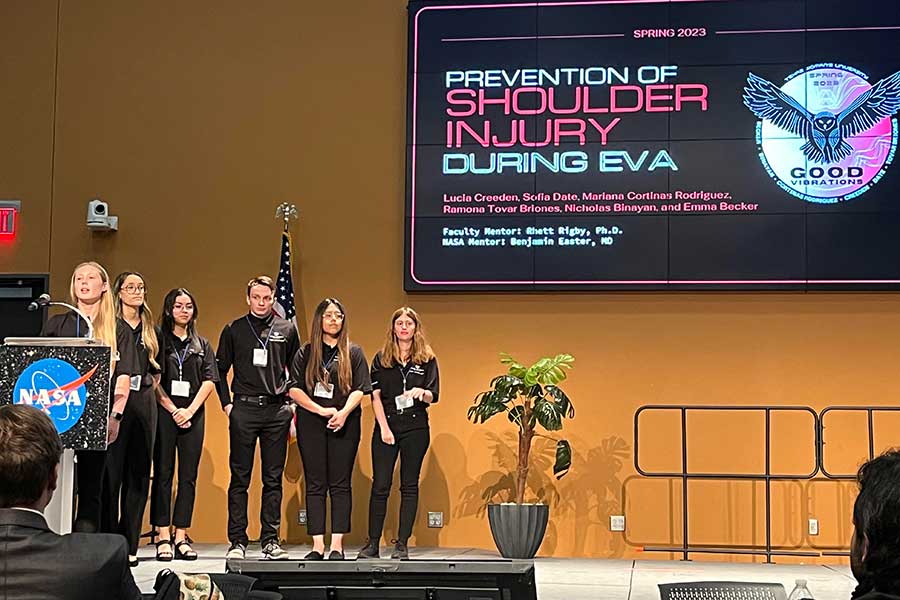Kinesiology team places fourth at NASA-sponsored competition

April 26, 2023 - DENTON -Astronauts train for their space missions in a 6.2 million gallon neutral buoyancy lab,which helps astronauts simulate the weightless environment of space. During trainings, astronauts wear large, bulky space suits, and moving one’s upper body in the rigid spacesuit can lead to shoulder injuries.
Knowing that, a Texas Woman’s team of senior kinesiology students created a wearable device for astronauts that signals when unsafe arm positions are detected. The team’s project placed fourth overall at the Texas Space Grant Consortium Design Challenge, a NASA-sponsored science competition.
The six-member TWU team also took first in oral presentation and was fourth in peer review. Team members Lucia Creeden, Mariana Cortinas Rodriguez, Emma Becker, Ramona Tovar Briones, Nicholas Binayan and Sofia Date received scholarships from TSGC for their project, based on a research problem identified by NASA.
The fourth-place finish extended a successful run for the School of Health Promotion and Kinesiology’s internship team. Over the last 10 semesters that Texas Woman’s teams have entered the competition, they have placed in the top four eight times. They have taken the top prize three times.
The TWU team, who called themselves Good Vibrations, was the only kinesiology department represented at the two-day competition held at the UT Tyler Houston Engineering Center. The majority of the 16 college teams in the competition were made up of engineering students.

At this semester’s competition, the team created a device to prevent injuries to muscle, cartilage and tissue in the shoulder. This device improved on projects by the Fall 2019 and Spring 2020 teams.
“The project itself was a device that astronauts would wear on their shoulders,” faculty advisor Rhett Rigby, PhD, said. “The team designed a shirt that had pockets sewn into it, and the device went into the pockets. The device measured how far the arm is from your body.”
If the astronauts were wearing the device under their space suits, they would feel a vibration on their shoulder blades when they move their shoulders into unnatural positions. Prior to the competition, the team tested the device underwater at the pool in Pioneer Hall to simulate that weightless environment. The students spent a lot of time prepping the person who went underwater, creating the waterproof suit to protect the device and hiring a divemaster to accompany the tester.
“The team put their hearts into the project,” Rigby said. “The project was very good but there was so much more to the project that wasn’t presented. I am very appreciative of their efforts on those behind-the-scenes details.”
With their health science backgrounds, members of the TWU team were focused on creating an innovative device designed to improve mobility for astronauts. “The team received compliments at the competition that they do this cross-disciplinary research even though they are not traditionally trained in it,” Rigby said. “They learn it on the fly and they can apply it in a way that is incredibly competitive, and they can compete with engineers that have been learning this material for four years. I think it’s always beneficial to learn things that get you out of your comfort zone and stretch you academically.”
Media Contact
Amy Ruggini
Digital Content Manager
940-898-3628
aruggini@twu.edu
Page last updated 1:07 PM, May 30, 2024
/prod01/twu-cdn-pxl/media/images/health-promotion-kinesiology/20230403_DSC_7527---NASA-Underwater-Test_900px.jpg)
/prod01/twu-cdn-pxl/media/images/health-promotion-kinesiology/20230403_DSC_5206---NASA-Underwater-Test_900px.jpg)
/prod01/twu-cdn-pxl/media/images/health-promotion-kinesiology/20230403_DSC_6997---NASA-Underwater-Test_900px.jpg)
/prod01/twu-cdn-pxl/media/images/health-promotion-kinesiology/20230403_DSC_7074---NASA-Underwater-Test_900px.jpg)